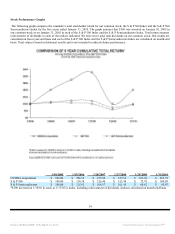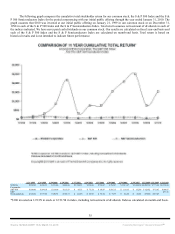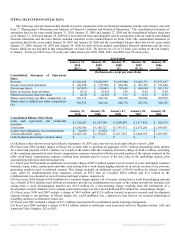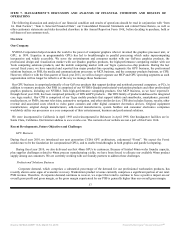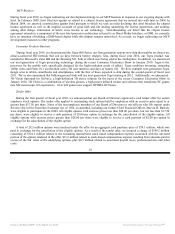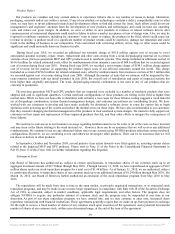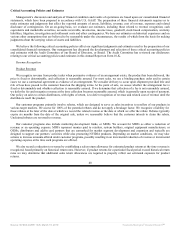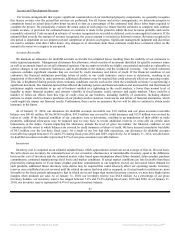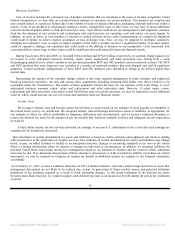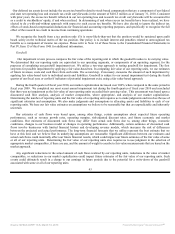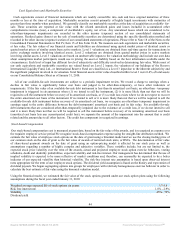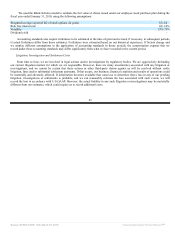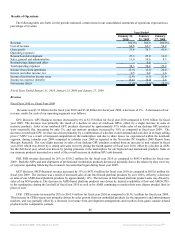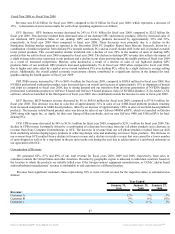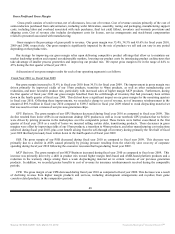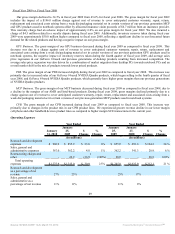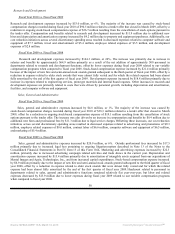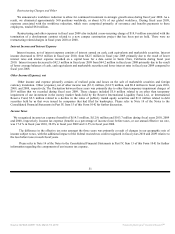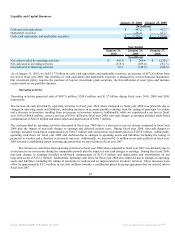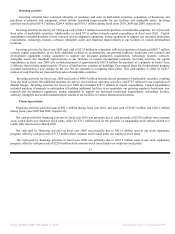NVIDIA 2010 Annual Report Download - page 57
Download and view the complete annual report
Please find page 57 of the 2010 NVIDIA annual report below. You can navigate through the pages in the report by either clicking on the pages listed below, or by using the keyword search tool below to find specific information within the annual report.
Our deferred tax assets do not include the excess tax benefit related to stock-based compensation that are a component of our federal
and state net operating loss and research tax credit carryforwards in the amount of $401.5 million as of January 31, 2010. Consistent
with prior years, the excess tax benefit reflected in our net operating loss and research tax credit carryforwards will be accounted for
as a credit to stockholders’ equity, if and when realized. In determining if and when excess tax benefits have been realized, we have
elected to do a with-and-without approach with respect to such excess tax benefits. We have also elected to ignore the indirect tax
effects of stock-based compensation deductions for financial and accounting reporting purposes, and specifically to recognize the full
effect of the research tax credit in income from continuing operations.
We recognize the benefit from a tax position only if it is more-likely-than-not that the position would be sustained upon audit
based solely on the technical merits of the tax position. Our policy is to include interest and penalties related to unrecognized tax
benefits as a component of income tax expense. Please refer to Note 14 of these Notes to the Consolidated Financial Statements in
Part IV, Item 15 of this Form 10-K for additional information.
Goodwill
Our impairment review process compares the fair value of the reporting unit in which the goodwill resides to its carrying value.
We determined that our reporting units are equivalent to our operating segments, or components of an operating segment, for the
purposes of completing our goodwill impairment test. We utilize a two-step approach to testing goodwill for impairment. The first
step tests for possible impairment by applying a fair value-based test. In computing fair value of our reporting units, we use estimates
of future revenues, costs and cash flows from such units. The second step, if necessary, measures the amount of such impairment by
applying fair value-based tests to individual assets and liabilities. Goodwill is subject to our annual impairment test during the fourth
quarter of our fiscal year, or earlier if indicators of potential impairment exist, using a fair value-based approach.
During the fourth quarter of fiscal year 2010, our market capitalization increased over 100% when compared to the same period in
fiscal year 2009. We completed our most recent annual impairment test during the fourth quarter of fiscal year 2010 and concluded
that there was no impairment as the fair value of our reporting units exceeded their carrying value. This assessment was based upon a
discounted cash flow analysis, analysis of market comparables, where appropriate, and analysis of our market capitalization.
Determining the number of reporting units and the fair value of a reporting unit requires us to make judgments and involves the use of
significant estimates and assumptions. We also make judgments and assumptions in allocating assets and liabilities to each of our
reporting units. We base our fair value estimates on assumptions we believe to be reasonable but that are unpredictable and inherently
uncertain.
Our estimates of cash flows were based upon, among other things, certain assumptions about expected future operating
performance, such as revenue growth rates, operating margins, risk-adjusted discount rates, and future economic and market
conditions. Our estimates of discounted cash flows may differ from actual cash flows due to, among other things, economic
conditions, changes to our business model or changes in operating performance. Additionally, certain estimates of discounted cash
flows involve businesses with limited financial history and developing revenue models, which increases the risk of differences
between the projected and actual performance. The long-term financial forecasts that we utilize represent the best estimate that we
have at this time and we believe that its underlying assumptions are reasonable. Significant differences between our estimates and
actual cash flows could materially affect our future financial results, which could impact our future estimates of the fair value of some
or all of our reporting units. Determining the fair value of our reporting units also requires us to use judgment in the selection of
appropriate market comparables, if there are any, and the amount of weight to ascribe to fair value measurements that are based on the
market approach.
Any significant reductions in the actual amount of cash flows realized by our reporting units, reductions in the value of market
comparables, or reductions in our market capitalization could impact future estimates of the fair value of our reporting units. Such
events could ultimately result in a charge to our earnings in future periods due to the potential for a write-down of the goodwill
associated with some or all of our reporting units.
43
Source: NVIDIA CORP, 10-K, March 18, 2010 Powered by Morningstar® Document Research℠


